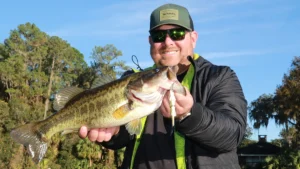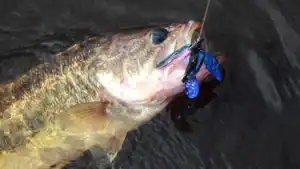Sometimes, regardless of what we try, the bass just won’t bite. We do the research, use our favorite lures, put in the time and still, we get totally skunked. Goose egg. Zilch. Nada. It’s enough to drive even the most experienced anglers crazy, but these frustrating outings often lead to unique innovations that result in incredibly effective bass fishing techniques.
Case in point: Alabama fishing guide Jimmy Mason. He makes his living teaching people how to catch bass. But what if they’re not biting? What if his clients are unable to properly operate a baitcaster? What if they’ve never held a fishing rod before? It’s up to him to provide quick and simple solutions to these frequent obstacles.
Enter the finesse Carolina rig. As the name implies, it’s a much smaller version of the traditional Carolina rig, but its fish-catching prowess more than makes up for its diminutive profile. Since implementing this technique into his bass fishing arsenal, Mason has enjoyed a monumental increase in the quantity, and even the quality, of he and his clients’ catch.
This article is going to be straightforward. No fancy verbiage or in-depth biology lessons; just a down and dirty tutorial to a phenomenal way to catch a bunch of bass. Here’s what you need to know.
- Why does it work?
- Equipment considerations
- Bite detection and hookset
- Bait selection
What’s so special about it?
Much like the shaky head, a finesse Carolina rig has an inherent ability to draw strikes when larger, bulkier presentations fail. More importantly, however, it’s easy to fish and doesn’t require much, if any, rod movement to achieve a tantalizing action.
“I started doing this several years ago while guiding,” Mason said. “I have a lot of clients who can’t throw a baitcaster and haven’t quite developed the feel for a traditional Texas rig. This allows someone to easily maintain bottom contact and get a bunch of bites in the process. You don’t have to do anything special, either.”
At some point in time, we’ve all been guilty of overemphasizing the importance of our rod movement throughout our retrieve. But when the fishing action is slow, sudden movements can overpower the bass and appear unnatural. That’s why the “do nothing” nature of the finesse Carolina rig is so effective.
“When I have someone who is very inexperienced, I’ll have them make a long cast, let it sink to the bottom and slowly turn their reel handle,” Mason said. “You just let the bottom do the work for you, every rock and stick with which it collides causes an erratic movement. For more experienced anglers, I suggest a simple drag-and-pause retrieve. You can’t be too aggressive with your retrieve because the lighter weight will lose contact with the bottom, so the simpler you can make it, the more productive you’ll be.”
Attention to detail is the primary factor in maximizing your effectiveness with this rig. Each time you get a bite, you need to make a mental note of several things: Did the bite occur on the pause? Did the bite occur while I was moving my bait? Was I steadily reeling my rig? This technique can be incredibly simple to pattern, so just remember, ”there aren’t any flukes. The fish bit at a certain point in your retrieve for a very specific reason.
Equipment and rigging is paramount
The setup of a conventional Carolina rig can become quite complicated at times, but here’s the beautiful thing about a finesse Carolina rig, it’s simple. There’s no need to stress over the small details because a basic understanding of its key components is all that’s necessary for some great fishing action.
Rod
First and foremost, Mason suggests using a spinning rod in order to avoid overpowering the rig. He prefers a 7-foot, 6-inch medium-heavy Lew’s Custom Speed Stick Magnum 3 Spinning Rod. It’s important to use a rod with a solid backbone and a softer tip in order to let the rod “load” during the hookset. More on that later.
Reel
“I like using a big spinning reel with a lot of line capacity,” Mason said. “We’re usually making long casts, so a larger spool comes in handy. My clients and I have been using a 4000 series Lew’s Team Pro Speed Spin Spinning Reel with a lot of success.”
Weight
Mason’s weight selection process is quite simple. His personal favorite is a 3/8-ounce Elite Tungsten Flippin’ Weight. When fishing in deeper water, he’ll bump up to a 1/2-ounce sinker and if he finds himself in water less than 5 feet deep, he often downsizes to a 1/4-ounce sinker.
Bead
“I haven’t really noticed the bead color making a huge difference on this rig,” Mason said. “So I don’t stress out over it. I’ve used orange beads, clear beads and even red beads with equal success. The main point of the bead is to protect your knot from the weight beating against it.”
Hook
A lightwire hook is certainly advantageous. Not only does it allow the bait to appear more natural and free-flowing, but it also allows for faster penetration at the end of a long cast. Mason has been using the 3/0 Mustad Grip Pin Hook lately and has found it to be an excellent option.
Line
In order to increase sensitivity and help his clients achieve a solid hookset, Mason utilizes the no-stretch properties of 15-pound Vicious Braid for his main line. For his leader material, he prefers 12-pound Vicious Pro Elite Fluorocarbon over monofilament because of its low visibility and low stretch on the hookset.
Leader length
“I use a 12 to 18-inch leader at all times with this rig,” Mason said. “Because you’re using such a light weight, you don’t get the same performance out of a long leader. It doesn’t cast as well, it doesn’t ‘behave’ as well and it also gets snagged more frequently. A shorter leader maintains bottom contact easier and can easily come through taller grass, shell beds and even large brush piles. You can throw this short leader anywhere, really.”
Bite detection and hookset technique
Detecting bites on a finesse Carolina rig may take a bit of practice initially, but within a few hours, most of Mason’s clients become pretty darn good at it.
“You’ll get a few of those mushy-feeling bites like you would with a traditional Carolina rig, but this short leader takes a lot of the guess work out of it,” Mason said. “Most of your bites will feel like a ‘tick, tick’ while other times you’ll simply feel the fish start to pull away from you.”
When it comes time to set the hook, resist the urge to execute a monstrous hookset. It’s a tough habit to break, but a more subtle hookset will result in a near-perfect landing ratio.
“The neat thing about this rig is that all you have to do is slowly pull against the fish and start reeling,” Mason said. “It’s really that simple. Taking up slack and setting the hook isn’t too critical. So when you get a bite, just reel down to the fish until your rod begins to load, or bend, then pull pack. Anyone can do it and enjoy an awesome landing percentage. I recently had a 14-year-old boy catch an 8-pound, 11-ounce largemouth on this rig.”
Bait considerations
Because of the subtle, natural presentation of the finesse Carolina rig, your bait selection process doesn’t need to be complicated. Mason and his clients rely on four primary baits throughout the entire year.
Lizard
While many anglers believe lizards to be a springtime-only bait, Mason uses a YUM Lizard throughout the entire year. It’s definitely at its best throughout the spring months, but it can be equally effective when the bass are feeding aggressively and prefer a larger meal.
Craw
“If you’re faced with stained or muddy water, a soft-plastic craw such as a YUM Mighty Craw can work wonders,” Mason said. “These baits have a great kicking action, which appeals to a bass’ lateral line in areas with low visibility. They may not be able to see very well, but they’ll certainly feel a craw bait flapping and thumping nearby.”
Stick worm
Bluebird skies may be aesthetically pleasing to anglers, but they’re often indicative of post-frontal weather and high barometric pressure. To combat these tough conditions, Mason suggests using a subtle stick worm, such as a 4 or 5-inch YUM Dinger. Its slow-sinking action and delicate side-to-side shimmy has a unique way of fooling stubborn bass.
Small swimbait
“When I notice a lot of baitfish in the area, I’ll use a pretty non-traditional approach by rigging a small YUM Swim’n Dinger on my finesse Carolina rigs,” Mason said. “If you see some bass busting shad on the surface but can’t get a bite, throw this rig past the surface activity and drag it underneath the school. You’ll be pleasantly surprised.”
So there you have it: The finesse Carolina rig. It’s not too elaborate, it’s not necessarily “sexy”, but it’ll save you on your toughest days of fishing. Whether you’re scrambling for a bite in your next jackpot derby, teaching your son or daughter to bass fish or simply looking for a good time at your local pond, you owe it to yourself to try this productive rig.


















